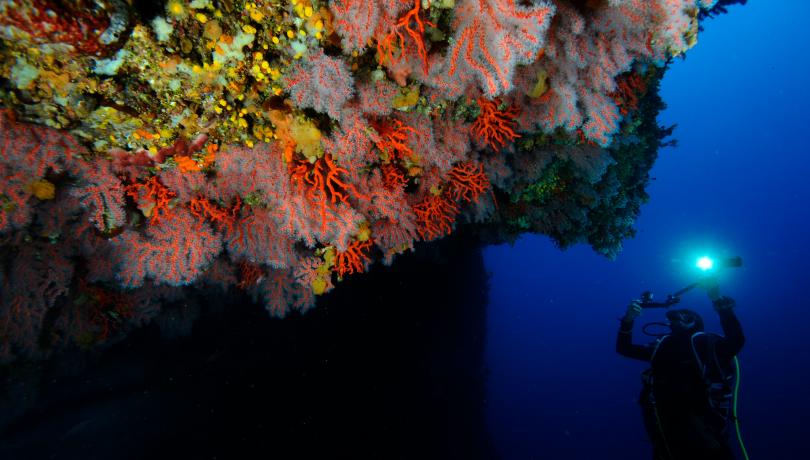The report 'State of Nature in Catalonia 2020' underlines the importance of marine reserves for the recovery of marine biodiversity on the Catalan coast.

The Mediterranean Sea, which occupies less than 1% of the planet's marine surface, is home to 10% of all marine species, of which 30% are endemic. However, according to the report 'State of Nature in Catalonia 2020' presented today, in areas such as Catalonia there is a lack of basic information on marine biodiversity to guarantee its conservation.
Furthermore, the document reveals that overfishing and demographic pressure on the Catalan coast are having increasingly important impacts on marine environments. In this sense, the report highlights that fishing techniques such as trawling impoverish the seabed and accidentally trap endangered species such as some cartilaginous fish (in Catalonia 65% of sharks and 42% of rays are already endangered), turtles and birds (especially shearwaters).
Given this scenario, the document underlines the importance of marine reserves for the recovery of many species, and points out the example of the Medes Islands Marine Reserve, where fish populations have increased, especially within the reserve, but also in the peripheral area.
On the other hand, the report confirms that climate change is having obvious effects on the Catalan marine environment, such as the proliferation of species associated with increasing water temperature such as some jellyfish and filamentous algae, and the recurrence of marine heatwaves, which are causing more frequent episodes of massive mortality of different species. According to the document, these episodes often affect species of commercial interest, such as the mussel in the Ebro Delta.
"In the XXI century, the sea in Catalonia continues to be a great unknown. We do not have information as basic as a good mapping of marine habitats, nor do we have enough data on the conservation state and evolution of the populations of emblematic species included in treaties. Without these data, efficient measures that favor the recovery of marine biodiversity cannot be implemented", regrets the ICM researcher and author of the report Joaquim Garrabou.
In general, the report "State of Nature in Catalonia 2020" shows that Catalonia is experiencing a progressive and generalized decline in its biodiversity, which has been reduced by 25% in the last eighteen years. However, according to this document, the biodiversity loss in Catalonia is not the same in the different environments or habitats, but is 54% in the case of species living in rivers, lakes and wetlands; 34% in species from agricultural environments and meadows; and 12% in species that find refuge in forests and bushes.
The report's conclusions indicate that changes in land use and direct exploitation are the main responsible for biodiversity loss in non-marine environments, although it is observed that climate change and the arrival of invasive alien species have an impact growing. The origin of this trend is, according to this document, a socioeconomic model that intensifies the obtaining of resources in certain areas and abandons others that had been used more sustainably.
Result of a collective effort
The report published today has been commissioned by the Department of Territory and Sustainability to the Center for Forest Science and Technology of Catalonia (CTFC) and the Center for Ecological Research and Forest Applications (CREAF) ", which have prepared the document together with the Catalan Ornithology Institute (ICO) and the ICM. The data has been extracted from more than 40 research entities, universities, administrations, private associations and NGOs and hundreds of volunteers involved in citizen science projects.
For the Report’s preparation, the Living Planet Index (LPI) has been adapted to the Catalonia context. This is a global indicator used by the United Nations to monitor biodiversity and is based only on information on vertebrate animals. In the case of Catalonia, as have done other European countries, information on invertebrates (only butterflies) has been added. The LPI-Cat has been calculated from the trend data of 321 species included in 7 large-scale and long-term monitoring programs that are active in Catalonia nowadays.
Need to strengthen conservation policies
The results of the report support the need to deploy an ambitious and effective policy for the conservation of the natural environment and biodiversity. This document aims to be the beginning of the evaluation of the development of the Strategy for Natural Heritage and Biodiversity 2030. For this reason, it includes some of the concrete actions that have been carried out in Catalonia to reverse the biodiversity loss. These include protecting natural spaces through the Network of Protected Spaces of Catalonia or creating plans and actions for the conservation of threatened species. These and other actions have made it possible to mitigate the biodiversity loss and recover the populations of some highly threatened species such as the otter, the brown bear, or the lesser kestrel, among others.